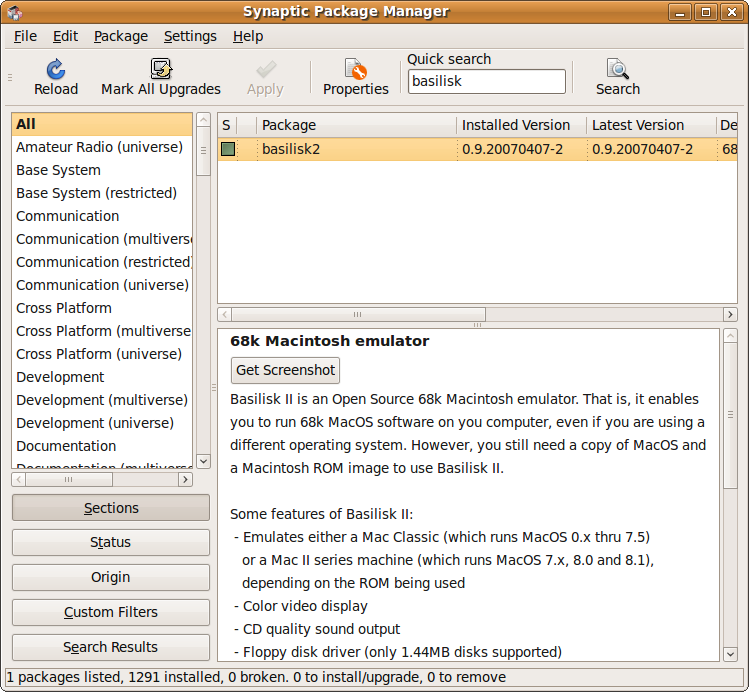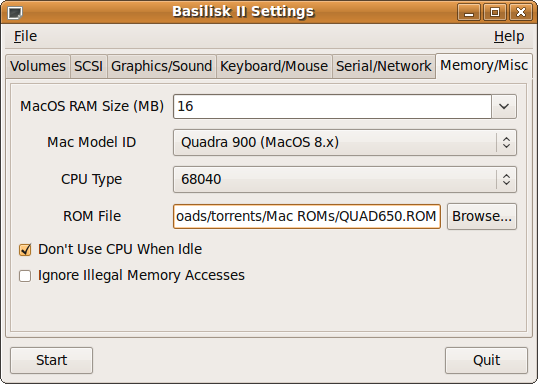The Hardware Emulator
With the departure of vMac mini and with most of the other emulators targetting Windows hosts (such as SoftMac from Emulators.com), there's really only one choice for Mac Classic emulation - Basilisk II. It's been around for a fair amount of time, runs on almost any operating system (with the notable exception of OS/2 / eComStation) and is surprisingly stable.
Installation under Ubuntu up to (but not including) 10.04 is as simple as selecting it for install from Synaptic Package Manager.

The only problem with the Basilisk II installation is that it does not create a menu entry by default, so you will have to do this manually, or run it from the command-line. Either way, be aware of the capitalization of the program name: "BasiliskII".
Unfortunately, this package has been subsequently removed from newer version of Ubuntu. Installing from source is usually an exercise is frustration - however, thankfully you can still install the Debian packages from old releases.
Once the application is installed, it is still fundamentally useless - you will need a ROM image and an operating system.
The ROM
You biggest challenge is going to be obtaining a ROM image. What the heck is a ROM image? Well, Apple decided early on that in order to control the hardware and software relationship and interdependency of the Mac, they would place a lot of extra functionality onto the machine's internal ROM directly. This would have the business benefit of locking in the operating system to hardware which only Apple would allow, and making the machine unique enough that only Apple could effectively provide an operating system for it. Oddly enough, this sort of thing is called "product tying" and many people have gotten into trouble for doing it, but somehow the magic of Apple seems to sway even the toughest of judges to rule in Apple's favour.
Sorry for going off on a tangent there - back to the ROM. The big problem here is that the ROM is tightly protected legally. It is completely illegal to own an image of the ROM without actually owning a Macintosh computer. This is a quirky thing that large companies tend to do - the old Mac classic is a thing of history. Apple is not interested in selling them or supporting them, and yet they will exert extreme legal force if anyone should tinker with their old dead products. What for? There's no money to be made by keeping it close to your chest anymore, and you're certainly not losing any money by someone copying it now.
Apple seems split with 2 different cultures. On the one hand, they protect the ROM image as a trade secret, but on the other they offer the old Macintosh System 7 (right up to 7.5) completely free on their site.
So how do you go about extracting the ROM image from an old Mac you own? I have no idea, and frankly I couldn't be bothered to figure it out. If you have an old 80's Mac, chances are it's not even working anymore, so installing software on it to copy the ROM image and then copy it off isn't exactly going to work. Luckily, there are a few folks out there who couldn't be bothered with legal matters, and so offer up Apple ROM images gratis. I'm sure if you look hard enough you can find them.
Once you have a suitable ROM image, you can launch Basilisk II and specify the ROM file under the "Memory/Misc" tab.

The Operating System
Obtaining an operating system for your newly created Mac isn't as hard as you might think - Apple has graciously released Macintosh System 7 up to 7.5.3, as mentioned earlier in directly the opposite mindset as their ROM.
However, you will notice one thing - the files are in an archived format which can only be extracted on a Mac. This is fairly problematic, since it is a Mac itself you are trying to create. Thankfully, Tony Taylor and Michael Goodine in their site offering tips for installing Mac emulation offer up a rather nicely bundled "starter" drive image, which includes the required "Stuffit Expander" for extracting the packaged System 7 installation.
To begin your installation, you will need to download this starter image, and define it as
How-To Guides
Step-by-step guides on installing and configuring environments and emulators.
- Apple ][
- Amiga
- Arcade
- Atari
- Commodore 64
- PC DOS
- Mac Classic (68K CPU)
- Mac PowerPC